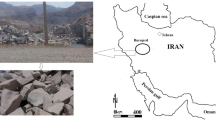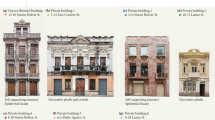Abstract
Determination of the mechanical strength of stones after freeze–thaw action is important for evaluating the durability of natural building stones used in cold regions. In this research, we proposed a novel physico-mechanical parameter (PMP) for estimating the mechanical strength of travertines after a freeze–thaw test, which is based on initial mechanical strength, effective porosity, and mean pore size of the stones. For this purpose, 12 samples of travertines were selected and their initial mechanical strengths (uniaxial compressive, Brazilian tensile and point load strengths), effective porosity, and mean pore size were determined. Then a freeze–thaw test was conducted up to 60 cycles on samples, and their mechanical strengths were measured. The results showed that PMP is in good accuracy for estimating the mechanical strengths of stones after a freeze–thaw test, and thus making a rapid durability assessment. As a result, the PMP avoids performing a freeze–thaw test, which is laborious and time-consuming.













Similar content being viewed by others
References
Altindaga R, Alyildizb IS, Onarganc T (2004) Mechanical property degradation of ignimbrite subjected to recurrent freeze–thaw cycles. Int J Rock Mech Min Sci 41:1023–1028
Angeli M, Bigas JP, Benavente D, Menendez B, Hebert R, David C (2007) Salt crystallization in pores: quantification and estimation of damage. Environ Geol 52:205–213
Anon OH (1979) Classification of rocks and soils for engineering geological mapping. Part 1: Rock and soil materials. Bull Int Assoc Eng Geol 19:355–371
Bayram F (2012) Predicting mechanical strength loss of natural stones after freeze–thaw in cold regions. Cold Reg Sci Technol 83–84:98–102
Beier N, Sego DC (2009) Cyclic freeze–thaw to enhance the stability of coal tailings. Cold Reg Sci Technol 55:278–285
Bell FG (2000) Engineering properties of soils and rocks, 4th edn. Blackwell Science, London
Benavente D, García del Cura MA, Fort R, Ordóñez S (2004) Durability estimation of porous building stones from pore structure and strength. Eng Geol 74:113–127
Benavente D, Martinez-Martinez J, Garcia del Cura MA, Canaveras MA (2007) The influence of petrophysical properties on the salt weathering of porous building rocks. Environ Geol 52:215–224
Binal A, Kasapoglu KE (2002) Effects of freezing and thawing process on physical and mechanical properties of Selime ignimbrite outcrops in Aksaray–Ihlara valley (in Turkish). In: Proceeding of 6th regional, Rock mechanic symposium, Konya-Turkey, pp 189–196
Chen TC, Yeung MR, Mori N (2004) Effect of water saturation on deterioration of welded tuff due to freeze–thaw action. Cold Reg Sci Technol 38:127–136
Goudie AS (1999) Experimental salt weathering of limestone in relation to rock properties. Earth Surf Proc Land 24:715–724
Hall K (1999) The role of thermal stress fatigue in the breakdown of rock in cold regions. Geomorphology 31:47–63
ImageJ software package (2010) Software version 1.43 developed by W. Rasband and freely, Maryland, USA. Available from http://rsb.info.nih.gov/ij/index.html
ISRM (1981) Rock characterization testing and monitoring. In: Brown ET (ed) ISRM suggested methods. Pergamon Press, Oxford, p 211
Jamshidi A, Nikudel MR, Khamehchiyan M (2013) Predicting the long-term durability of building stones against freeze–thaw using a decay function model. Cold Reg Sci Technol 92:29–36
Jefferson DP (1993) Building stone: the geological dimension. Q J Eng Geol 26:305–319
Karaca Z (2010) Water absorption and dehydration of natural stones versus time. Constr Build Mater 24:786–790
Labus M, Bochen J (2012) Sandstone degradation: an experimental study of accelerated weathering. Environ Earth Sci 67:2027–2042
Martínez- Martínez J, Benavente D, Gomez-Heras M, Marco-Castaño L, García-del-Cura MA (2013) Non-linear decay of building stones during freeze–thaw weathering processes. Constr Build Mater 38:443–454
Matsuoka N (1990) Mechanisms of rock breakdown by frost action: an experimental approach. Cold Reg Sci Technol 18:253–270
Muneo H (1998) Micromechanical analysis on deterioration due to freezing and thawing in porous brittle materials. Int J Eng Sci 36(4):511–522
Mutluturk M, Altindag R, Turk G (2004) A decay function model for the integrity loss of rock when subjected to recurrent cycles of freezing–thawing and heating–cooling. Int J Rock Mech Min Sci 41:237–244
Nicholson D (2001) Pore properties as indicators of breakdown mechanisms in experimentally weathered limestone. Earth Surf Proc Land 26:819–838
Nicholson DT, Nicholson FH (2000) Physical deterioration of sedimentary rocks subjected to experimental freeze–thaw weathering. Earth Surf Proc Land 25:1295–1307
Rossi-Doria PR (1985) Laboratory tests on artistic stonework. The deterioration and conservation of stone. Studies and documents on the cultural heritage No. 16. Unesco, pp 235–242
Ruedrich J, Siegesmund S (2007) Salt and ice crystallisation in porous sandstones. Environ Geol 52:225–249
Ruedrich J, Kirchner D, Siegesmund S (2011) Physical weathering of building stones induced by freeze–thaw action: a laboratory long-term study. Environ Earth Sci 63:1573–1586
Ruiz VG, Rey RA, Celorio C (1999) Characterization by computed X-ray tomography of the evaluation of the pore structure of a dolomite rock during freeze–thaw cyclic tests. Phys Chem Earth Part A 7(24):633–637
Sperling CHB, Cooke RU (1985) Laboratory simulation of rock weathering by salt crystallisation and hydration processes in hot, arid environments. Earth Surf Process 10:541–555
Stocklin J, Setudinia A (1972) Lexique Stratigraphique International vol III ASIE. Centre National de la Recherche Scientifique. 15, quai Anatole-France (Paris-VII)
Takarli M, Prince W, Siddique R (2008) Damage in granite under heating/cooling cycles and water freeze–thaw condition. Int J Rock Mech Min Sci 45:1164–1175
Tan X, Chen W, Tian H, Cao J (2011) Laboratory investigations on the mechanical properties degradation of granite under freeze–thaw cycles. Cold Reg Sci Technol 68:130–138
Tuğrul A (2004) The effect of weathering on the pore geometry and compressive strength of selected rock types from Turkey. Eng Geol 75:215–227
Valdeon L, de Freitas MH, King MS (1996) Assessment of the quality of building stones using signal processing procedures. Q J Eng Geol 29:299–308
Yavuz H, Altindag R, Sarac S, Ugur I, Sengun N (2006) Estimating the index properties of deteriorated carbonate rocks due to freeze–thaw and thermal shock weathering. Int J Rock Mech Min Sci 43:767–775
Zezza U (1990) Physical-mechanical properties of quarry and building stones. Analytical methodologies for investigation of damage stones, Pavia, pp 1–20
Author information
Authors and Affiliations
Corresponding author
Rights and permissions
About this article
Cite this article
Jamshidi, A., Nikudel, M.R. & Khamehchiyan, M. A novel physico-mechanical parameter for estimating the mechanical strength of travertines after a freeze–thaw test. Bull Eng Geol Environ 76, 181–190 (2017). https://doi.org/10.1007/s10064-016-0873-7
Received:
Accepted:
Published:
Issue Date:
DOI: https://doi.org/10.1007/s10064-016-0873-7




